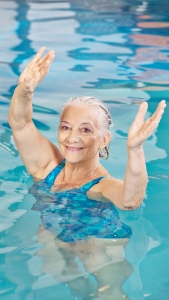By JORGE ESPINOSA
Aquatic therapy is great for all populations and a variety of aches and pains.
 The benefits of water in a therapeutic setting has been around since about 2000 B.C. and still holds strong to this day. With the level of water on the body, there is a reduction in gravity’s impact on the body, decreasing the pressure placed on joints and making it easier to move. (If you ever wanted to feel like you were an astronaut training, that is how they do it.)
The benefits of water in a therapeutic setting has been around since about 2000 B.C. and still holds strong to this day. With the level of water on the body, there is a reduction in gravity’s impact on the body, decreasing the pressure placed on joints and making it easier to move. (If you ever wanted to feel like you were an astronaut training, that is how they do it.)
With the temperature of a therapeutic pool between 92 and 96 degrees, you have the ability to relax the muscles more, so any stiff muscles can loosen up a little, making it easier for muscle groups to move like they once did.
But you don’t need a therapeutic pool to perform water exercises. Performing just general walking inside a pool, forward, sideway and backward, as long as you are comfortable, could improve endurance, restore functionality and help with independence.
Water exercise can help those with:
- Cardiovascular dysfunction, by reducing blood pressure, improving cardiac output and making heart work more efficiently, without the same work load as working out at the gym.
- Pulmonary dysfunction, by giving patients the ability to have resistance training for respiratory muscle groups against water, making inhaling easier for those having issues with it.
- Restricted range of motion of joints. With a heated pool, relaxation of muscle groups allows for ease of movements.
- Pain and chronic pain conditions. Thermal effects allow more blood circulation to the areas needed by reducing gravity and body weight to reduce pain.
- Weight-bearing restrictions. People with weight-bearing restrictions are able to reduce the load on their joints and gradually improve their tolerance on the effected joint, as with athletes after a knee surgery or hip surgery.
As per one textbook study, “Evidence was documented to support aquatic therapy in the management of osteoarthritis, rheumatoid arthritis, joint arthroplasty, fibromyalgia, low back pain, strokes, acquired brain injuries, spinal cord injuries, Guillain Barre syndrome, cerebral palsy of both adult and child, muscular atrophy, obesity, osteopenia, chronic obstructive pulmonary disorder, heart failure and sports-specific rehabilitation.”
Overall, pediatric patients to geriatric patients and everyone in between can use aquatherapy to improve abilities, to stand for longer periods of time, return to sports after injuries and potential surgeries, and improve mobility and functionality for geriatric patients who are not able to get around as they normally would.
Learn more about Lakeland Regional Health’s Outpatient Physical Rehabilitation services.
About the Author
Jorge Espinosa is a Lakeland Regional Health physical therapist who is certified in aquatics therapy.
